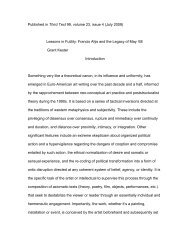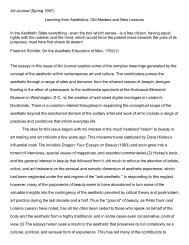Art Journal interview with Mick Wilson - Grant Kester
Art Journal interview with Mick Wilson - Grant Kester
Art Journal interview with Mick Wilson - Grant Kester
Create successful ePaper yourself
Turn your PDF publications into a flip-book with our unique Google optimized e-Paper software.
5. On Altaf's work see the catalogue for Groundworks:<br />
Environmental Collaboration in Contemporary<br />
<strong>Art</strong>, Regina Gouger Miller Gallery (Pittsburgh:<br />
Carnegie Mellon University Press, 2005). See also<br />
Park Fiction's website at www.parkfiction.org/.<br />
operate <strong>with</strong>in what I term a "textual" register, in which the work of art,<br />
whether it's an object, a space, or an event, is programmed ahead of time and<br />
then set in place before the viewer. I tend to write about works that involve a<br />
more open-ended form of participatory interaction, drawn out over extended<br />
periods of time. I'm thinking of projects like the water-pump sites and children's<br />
temples Navjot Altaf has helped organize in central India or Park Fiction's work<br />
in Hamburg.s These frequently use the workshop as a way to frame creative<br />
labor, or they involve the tactical mobilization of craft traditions. They also<br />
explicitly address the ethical relationship between the artist and his or her collaborators.<br />
One of the ways in which I'm trying to work through an evaluative<br />
model for these practices involves research at the interstices of the aesthetic, the<br />
ethical, and the tactical. This approach tends to be a taboo in art world, where<br />
open talk of ethics is anathema. I find this attitude intellectually disingenuous.<br />
The history of modern art is nothing if not an ongoing struggle to develop a<br />
compensatory cultural response to the dehumanizing effects of modernity,<br />
whether through the agency of a well-crafted object, paintings of bucolic Polynesians,<br />
or the therapeutic disruption of the viewer's perceptions. How is art not<br />
an expression of an ethical desire? Also, these projects don't rely as heavily on<br />
the epistemology of the "outside": in some cases they try to work productively<br />
<strong>with</strong>in particular matrices of institutional power and cultural exchange. While the<br />
art world is very comfortable <strong>with</strong> ironic distance, it has a much more difficult<br />
time understanding sincerity as anything other than a sign of naivet6 or intellectual<br />
weakness.<br />
Second, Bourriaud has been anxious to maintain a conventional avant-garde<br />
genealogy for the practices he discusses. As a result he's attempted to sequester<br />
them from the traditions of activist and community-based practice, <strong>with</strong> which<br />
they actually have much in common. Bourriaud describes relational practice as<br />
an epiphenomenal expression of the shift from industrial forms of labor to a service<br />
economy. If the artist under industrial production had the job of creating<br />
complex or well-constructed objects as an antidote to mass-produced dreck,<br />
then the postindustrial artist must now create alternative models of sociality to<br />
challenge the instrumentalizing of human social interaction in a postindustrial<br />
system. I don't think that current changes in art practice can be transposed in<br />
such a simple way from economic transformations, and I also don't buy the<br />
underlying assumption that "immaterial" labor is the site of the most decisive<br />
rearticulation of political power. In fact, many of the projects that interest me<br />
involve struggles over very material forms of labor-relative to land redistribution,<br />
water rights, or working conditions in maquiladoras.<br />
For me the proliferation of collaborative or collective practices suggests a<br />
certain exhaustion <strong>with</strong> some of the key points of tension that have traditionally<br />
defined and sustained avant-garde art-art versus kitsch, art versus activism, the<br />
artist versus the viewer, etc. Each of these oppositional pairs requires us to define<br />
art via distance and autonomy. In practice this tradition lends itself to a hygienic<br />
discourse, where the critic's job is to insulate approved avant-garde practice from<br />
contamination by other, degraded, cultural forms. I was discussing Park Fiction's<br />
work recently <strong>with</strong> a landscape designer who was dismayed by what she saw as<br />
the ugliness of the park they developed in conjunction <strong>with</strong> their Hafenstrasse<br />
neighbors. She described it as kitsch, which struck me as exactly right. Park<br />
112 FALL 2007




